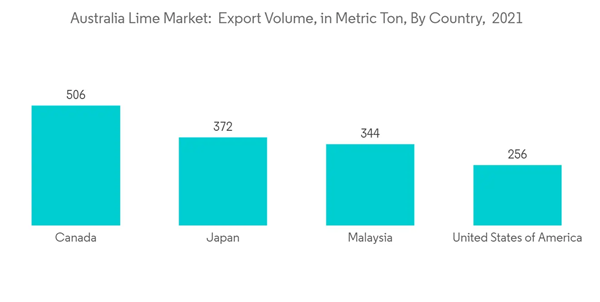Key Highlights
- Lime is used as an ingredient for producing citric acid, lime oil, lime juice, and other products used in household food items, as well as chores. Therefore, the growing demand for the products will eventually increase the demand for lime. As a result, the growing interest in health benefits and cleaning applications will be a major force driving the market. Lime is a versatile fruit with various uses, including as an ingredient in food products, cleaning agents, and personal care items. As the demand for these products increases, lime as a raw material will also rise.
- Lime is an excellent citric acid source, used as a natural preservative in food and beverage products. Additionally, lime juice and lime oil are popular ingredients in the cosmetic and personal care industries, as they offer a range of health benefits for the skin and hair.
- Furthermore, lime's natural cleaning properties make it a popular ingredient in household cleaning products, as it can effectively remove stains, grease, and other dirt from various surfaces. The growing interest in eco-friendly and natural cleaning solutions has also increased the demand for lime-based cleaning products. Overall, the demand for lime will likely continue to grow due to its versatility and various applications in different industries.
- According to the Sydney Markets, lime is in great supply and quite reasonable when purchased in bulk, costing USD 3-USD 7 per kilo or 30-60 each. The price of limes is slightly higher in major supermarkets, especially during the summer, due to increased demand for the fruit, as consumers are encouraged to utilize limes in tropical cocktails and cooking/salads.
- Even though lemons are abundantly found all across the nation, a few regions are known for their production. These areas include Darwin, Lismore, Riverland, Bundaberg, and Burnett. Due to emerging research, a few more variants have permeated the market. Some variants are Allen Eureka, Eureka seedless, Eureka SL from South Africa, Genoa, and Limoniera 8A.
- The country produces nearly 30,000-40,000 tonnes of limes yearly, with 28,000-35,000 tonnes produced year-round in Far North Queensland(FNQ). Limes, such as lemons, are the primary source of revenue for most FNQ growers. Further, the national exports are anticipated to increase slowly year on year.
Australia Lime Market Trends
Unique Health Benefits of Lime is Driving Australia Exports
- Lime is a fruit that has several unique health benefits. Lime is an excellent source of vitamin C, a powerful antioxidant that helps to protect the body from damage caused by harmful free radicals. Vitamin C also supports the immune system, helps the body absorb iron from plant-based foods, and plays a crucial role in collagen production, which is important for maintaining healthy skin, bones, and blood vessels. Overall, the unique health benefits of lime make it a great addition to a healthy and balanced diet. As consumers become more health conscious and aware of the benefits of consuming nutrient-dense foods, the demand for lime and other healthy fruits will likely continue to grow.
- Australia is increasing its export of limes, with the government encouraging farmers to export limes. Presently, only 4% of Australian limes are exported, with 87% sold on the domestic market. Seasonal market behavior has increased with time-specific consumption of lime and lime products, keeping the market in line and moving forward. According to the International Trade Center (ITC) Trade Map, Indonesia was Australia's major importer of lemons and limes, with 2,838 metric tons in 2021.
- The higher prices in international markets, increase in the policy initiatives such as reduction in tariffs, especially concerning Indonesia, and easy markets to export with respect to Singapore and Hong Kong are expected to drive the lemon and lime exports during the forecast period. Indonesia-Australia Comprehensive Economic Partnership Agreement has enabled the export of various agricultural products like oranges and limes with increased duty-free access and has paved the way for greater trade opportunities.
Production and Import Analysis of Limes
- Lime is a climate-sensitive crop, and adverse weather conditions can significantly impact its production. Australia has experienced a range of extreme weather events in recent years, including droughts, floods, and heat waves, which can all affect lime production.
- Additionally, the COVID-19 pandemic impacted global supply chains and disrupted trade flows, affecting lime production and export in Australia. Lime production accounted for 39.7 thousand tons in 2018, which reduced to 39.4 thousand tons in 2020.
- According to the Bureau of Meteorology, 2018 was the third hottest year of Australia, and in addition to it, November 2019 rainfall was the lowest on record for Australia. But the production increased in 2019 by 4% compared to 2018. The pandemic decreased production in 2020 in the country by 4.6% compared to 2019. The production increased in 2021 and is expected to continue to increase during the forecast period. However, Australia imports lime from the United States, Egypt, and Spain to meet the domestic demand. The imports exponentially increased in 2020 by 60.3% compared to 2019 due to the country's reduced production.
- Egypt is expected to be the major exporter during the forecast period. Lately, Australia is witnessing an increase in lemon plantings, as well as an increase in new growers entering the industry, according to Citrus Australia. With the increase in lemon plantings and new growers entering the industry, Australia has an excellent opportunity to capitalize on this demand and export its high-quality produce to international markets. Australia's strong reputation for delivering high-end produce is a significant advantage in the global market. Consumers worldwide are becoming increasingly concerned about food safety and quality. They are willing to pay a premium for products that have undergone rigorous inspections along all stages of the supply chain. Australia can position itself as a top player in the global lemon market by ensuring its produce meets these high standards.
Australia Lime Industry Overview
Additional Benefits:
- The market estimate (ME) sheet in Excel format
- 3 months of analyst support
Table of Contents
Methodology

LOADING...










